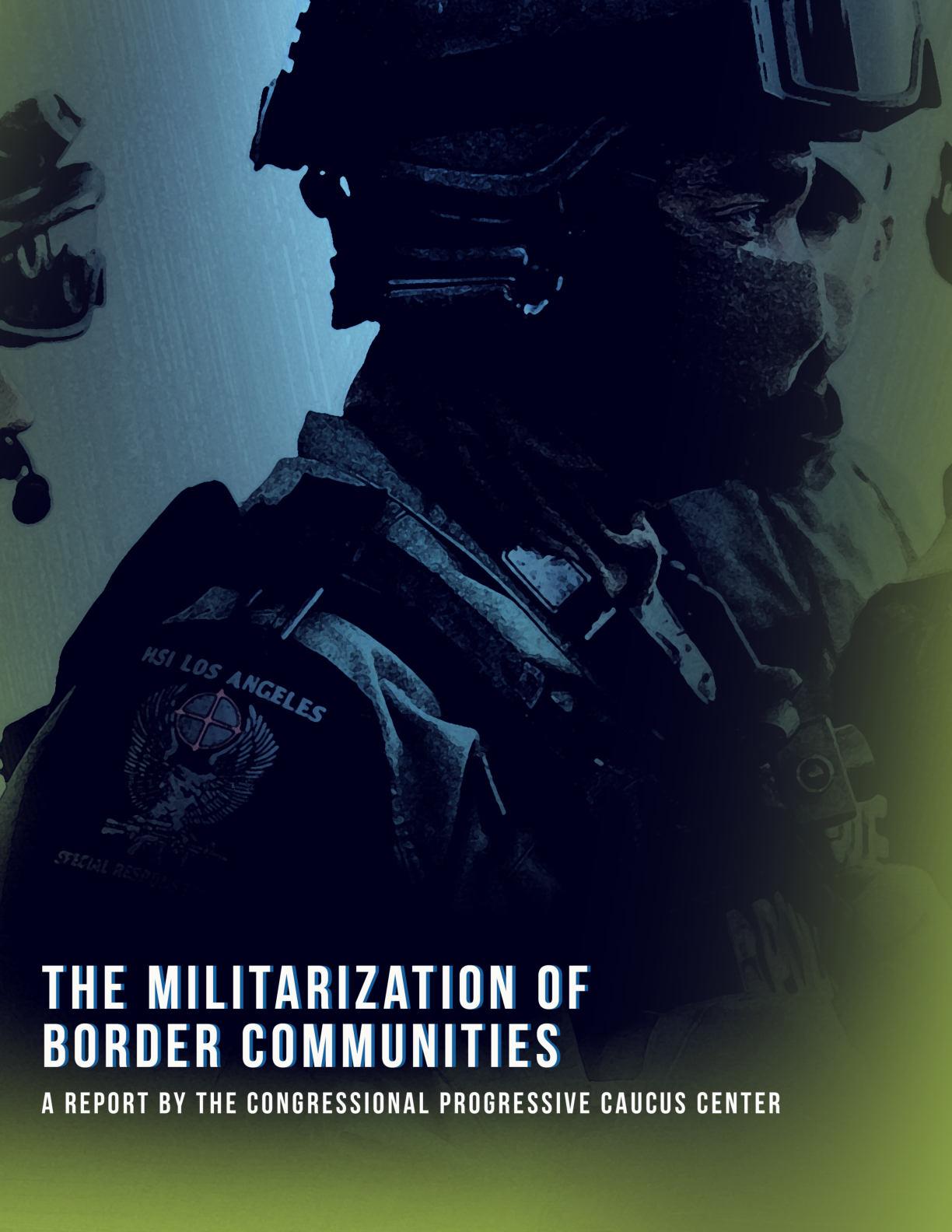
INTRODUCTION
MILITARY SPENDING AND MILITARIZED U.S. BORDERS
WHAT LED TO BORDER MILITARIZATION
THE LONG HISTORY OF MILITARIZATION AND VIOLENCE AT THE BORDER
IMMIGRATION ENFORCEMENT BEFORE THE DEPARTMENT OF HOMELAND SECURITY
U.S. MILITARISM ABROAD FUELS MILITARISM ALONG THE U.S. BORDER
THE CREATION OF DHS AND EXPANSION OF BORDER SECURITY
POST 9/11
THE BROAD AUTHORITY OF CBP AND ICE
TREATMENT OF MIGRANTS
DEATHS AT THE BORDER
ICE AND BORDER PATROL KILLINGS
ABUSE AND NEGLECT
CORRUPTION, LACK OF ACCOUNTABILITY AND OVERSIGHT CONCLUSION
WHAT CONGRESS AND THE ADMINISTRATION COULD DO
Note: This explainer is part of a series of reports that explore the relationship between excessive U.S. defense spending and the over-militarization of U.S. civilian communities. Additional explainers in the series will analyze the 1033 and 1122 weapons transfer programs, surveillance of communities of color, and federal policing of tribal lands. Access the full overview report here

3 4 6 13 17 21 23
U.S. militarism and excessive military spending have not only had devastating consequences abroad, but have also fueled the militarization of our border. Border militarization—or the systematic integration of military tactics and equipment into border security operations—has transformed U.S. borders into a de facto war zone with devastating and deadly consequences. Additionally, the increased use of violent military tactics along the U.S. border often subjects people coming into the country to racial profiling, criminalization, and violence. Moreover, communities and residents who live along the U.S. border often face restricted movement, militarized surveillance, and drained resources for social services. While the militarization of the U.S. border has a long history, the militarization of local and federal law enforcement in border communities has ballooned since the 1990s due to the sharp increase in spending on immigration enforcement, surveillance, and transfers of military-style weapons and technology. The U.S. budget for border and immigration control has increased by more than 6,000% since 1980. This sharp increase has made U.S. border communities—especially along the U.S.-Mexico border—some of the most militarized zones in the world and subjected these communities to violence, loss of civil liberties, and deadly racial profiling.
This report presents a historical overview of the border, the creation of our modern border and immigration enforcement programs, and historical and ongoing decisions that led to border militarization. This report is the second installment of a series of five reports. Our first report provided a synopsis of the series and analyzed the connections between the ballooning military budget and adverse outcomes for local communities. The remaining three reports will examine critical issues surrounding tribal policing, the 1033 and 1122 military equipment transfer programs, and the surveillance of Muslim communities.

Authors:
Chenelle Hammonds, chenelle@progressivecaucuscenter.org
Mariam Malik, mariam@progressivecaucuscenter.org
Jessica Juarez Scruggs, jessica@progressivecaucuscenter.org
Alex Samuels, alex@progressivecaucuscenter.org
CPCC thanks the American Friends Service Committee, Ground Game, the Institute for Policy Studies, and the National Immigrant Justice Center for their insights, comments, and contributions.
3
Sizable increases in immigration enforcement spending each year are made possible by the United States’ current massive $858 billion Pentagon budget—the largest in U.S. history. Increased military spending has resulted in a culture of mass surveillance and a cycle of militarization at the U.S. border, which puts border communities and families seeking safety at risk. Military-style weapons and technology are funneled to the Department of Homeland Security (DHS) through various Pentagon weapons transfer programs, such as the 1033 program. Additionally, the NDAA authorizes funding and sets policies for multiple operations at DHS. In 2020, former President Trump diverted $3.8 billion from the Pentagon to fund border wall projects. Defense contractors view a militarized border as an area for profit and continuously lobby for more weapons on the border to boost their revenue. All this, taken together, contributes to creating a militarized zone along U.S. borders.
Two of DHS’ militarized agencies are Immigration and Customs Enforcement (ICE) and Customs and Border Protection (CBP). Since the creation of DHS in 2003, the department has received more than $333 billion for immigration enforcement. Figure 1 on the following page shows annual appropriations for these agencies over time. Funding for ICE in 2021 was over $8.3 billion, while funding for CBP was over $17.7 billion. Taken together, this means the U.S. government spends more on federal immigration enforcement than all other federal law enforcement agencies combined. A large portion of ICE and CBP funding goes towards punishment and detention— mass prosecutions and jailing of migrants and asylum seekers, increasing raids on communities, and separating families.

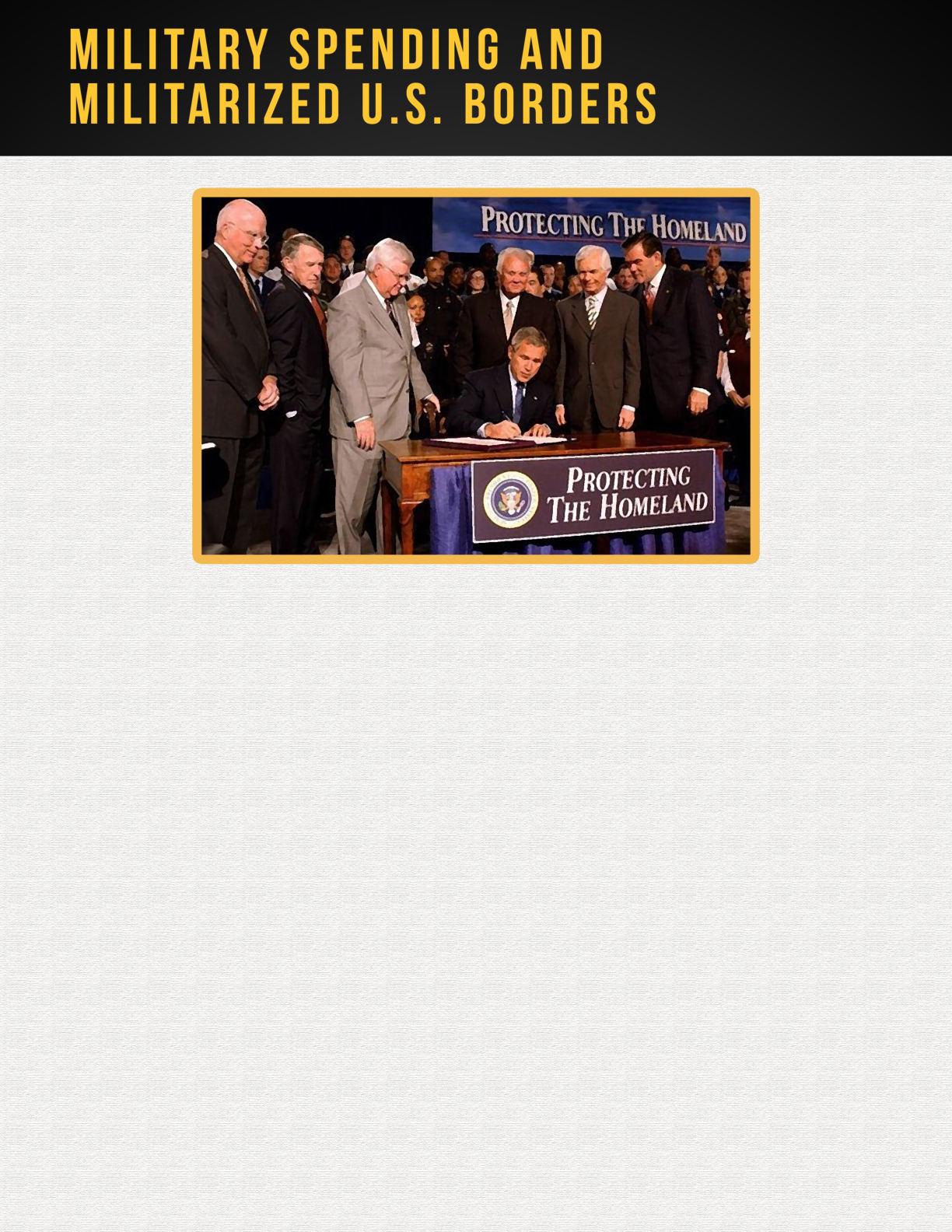 President George W. Bush signs the Homeland Security Appropriations Act of 2004 on October 1, 2003.
President George W. Bush signs the Homeland Security Appropriations Act of 2004 on October 1, 2003.
4
This excessive military spending contributes to militarization within and beyond U.S. borders. For example, the ongoing U.S. military footprint in countries around the world contributes to the violence and instability that causes people to seek safety in the U.S. and to build a better life. At the same time, the continual increase in Pentagon funding also contributes to militarization within U.S. federal, state, and local law enforcement agencies. For example, officers have effectively become deputized “soldiers” through programs that allow surplus military equipment to be transferred to non-military personnel. This policy encourages immigration enforcement officers to use militarized gear and war tactics to restrain and detain people in communities both around and far beyond the border. In recent years, ICE and CBP have been deployed in communities in response to peaceful protests and interior law enforcement operations. Similarly, ICE and CBP often tap local and state law enforcement agencies to assist and cooperate with them, despite limited authority to carry out immigration enforcement laws and policies. These involvements create a web of overlapping duties within distinctly different jurisdictions that contribute to higher rates of border violence and migrant abuse.


5
Figure 1. Department of Homeland Security appropriations by year, 1998-2021. ICE and CBP were founded in 2003. Pre-2003 appropriations are appropriations toward Border Patrol and equivalent departments that became ICE and CBP.
A Long History of Militarization and Violence on the Border

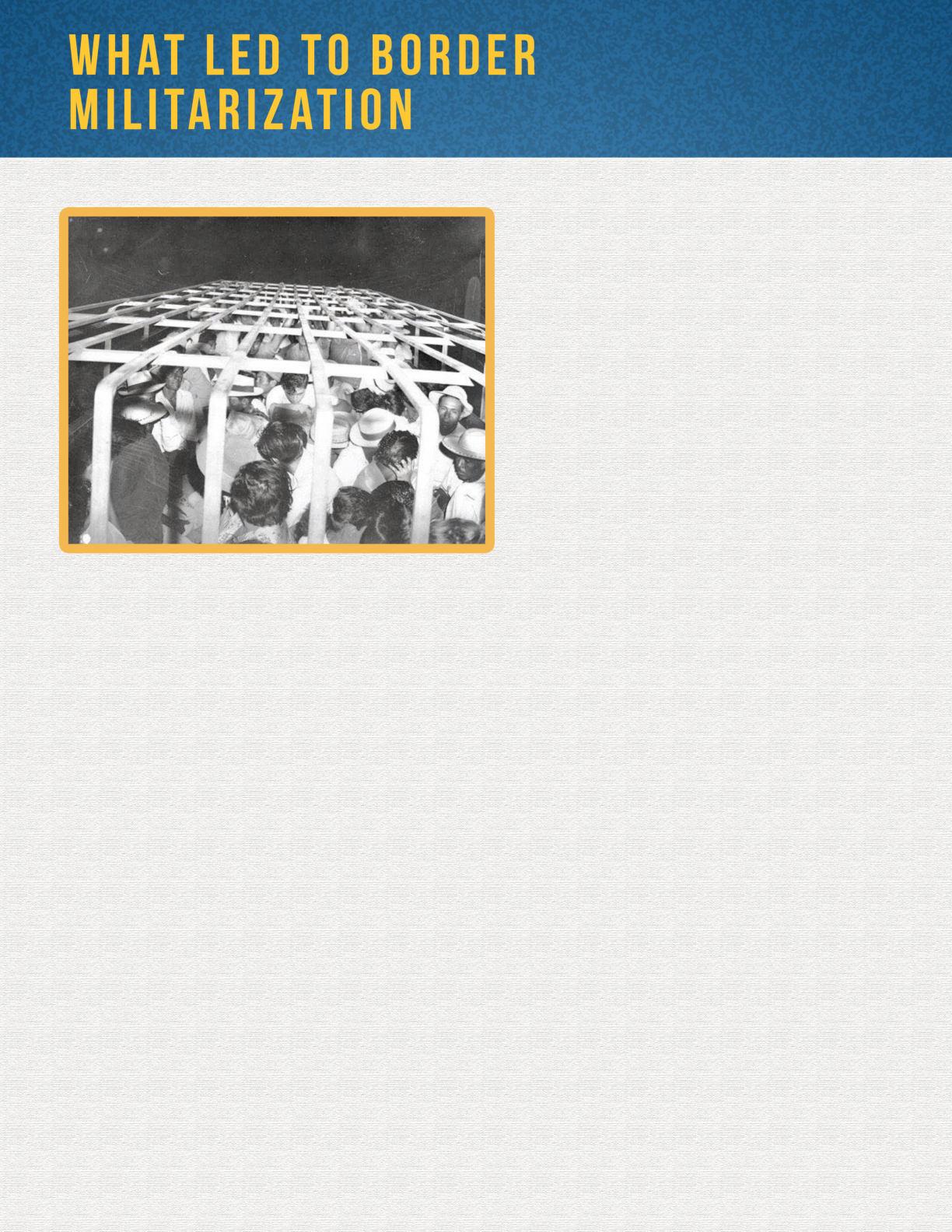
The U.S. has a long history of subjecting border communities— and people who cross borders— to military-style violence. For this report, we define border communities according to the same definition that CBP uses: A 100 air-mile radius from an international land or maritime border, also known as a “border zone.” According to the Southern Border Communities Coalition (SBCC), nearly two-thirds of the U.S. population lives within this “border zone”.
Many communities across the U.S. experience the impacts and ramifications of the “border zone” differently. For Indigenous people, the borders drawn by colonization artificially divide traditional homelands, families, and even modern-day reservations from the creation of the original 13 colonies to today. Similarly, border communities, especially along the U.S.-Mexico border, have endured prolonged conflict and shifting borders. For example, since 1846, families with deep roots along the Southern Border lived through multiple changes to the border and the open warfare that accompanied those shifts. During the same time, violent patrols tried to stop enslaved people from fleeing to freedom in Mexico.

6
The U.S. Border Patrol packed immigrants into trucks when transporting them to the border for deportation during "Operation Wetback." Source: U.S. Border Patrol Museum, June 9 1954.
Border Patrol officers detaining immigrants in a field after a few local raids. Source: U.S. Border Patrol Museum
Border patrol and immigration enforcement have a long history of aggressive and inhumane tactics, including family separation, deportation, and detaining people at the border, particularly based on race or country of origin. For example, Chinese immigrants were subject to mass violence, such as lynchings and mob attacks, before and after the passage of the Chinese Exclusion Act, which prevented most Chinese immigration from 1882 to 1943. Chinese-Americans were not the only targets of xenophobic and racist immigration laws. In the early 1900s, Congress passed restrictive and racialized immigration laws championed by the racist eugenics movement, which continued to gain prominence through the first half of the 20th century.
Immigration Enforcement Before the Department of Homeland Security

Before the Department of Homeland Security (DHS) was created in 2002, immigration was under the jurisdiction of the Department of Treasury beginning in the 1880s. U.S. customs collectors would collect a tax from immigrants at all ports of entry. The Immigration Act of 1891 created the Office of Superintendent of Immigration within the Treasury Department, which gave immigrant inspectors the power to inspect, admit, reject, and process all immigrants. These procedures eventually led to the creation of the Immigration and Naturalization Service (INS), which formalized immigration procedures, such as collecting paperwork and questioning arrivals about their intentions in the U.S.
As anti-immigrant sentiment and U.S. isolationism rose at the end of the 19th century, Congress passed a series of immigration laws imposing harsh racialized limits on immigration and restricting citizenship along racial lines, including the Immigration Acts of 1921 and 1924, which instituted a quota system. A quota system meant that the State Department would only issue a limited number of visas annually, and the Immigration Service only admitted those who arrived with a valid visa. This was the early stages of many bureaucratic delays to visa applications and the red tape many applicants face today.
The quota system also increased undocumented immigration because entry to the U.S. was restricted significantly for the first time. To manage undocumented immigration, Congress created the U.S. Border Patrol in 1924, which was a part of the Immigration Service. During this period, Mexican immigrants were subjected to dangerous and deadly “health” inspections by border control agents, which consisted of stripping people naked and spraying them with kerosene, gasoline, DDT, and even Zyklon B. U.S. officials justified these invasive and dangerous practices using xenophobic, racist, and false fears that migrant workers were spreading diseases. These violent and inhumane immigration enforcement practices continued for decades, including under the Bracero Program in the 1950s, which was a diplomatic agreement between the U.S. and Mexico that allowed Mexican men to legally work in the U.S. to address the labor shortage after WWI.
7
During World War II, a shift in the U.S. perspective on immigration began. Immigration became viewed as a national security matter instead of an economic one. Accordingly, the executive branch moved INS from the Department of Labor to the Department of Justice. As a result, boats filled with Jewish refugees from Europe were denied entry into the country during and before World War II. At the same time, the newly-established Border Patrol conducted mass deportations targeting Indigenous people, Mexican immigrants, and even Mexican-American U.S. citizens. Waves of mass deportations, often without any due process, continued along the Southern Border from the 1930s to the 1950s.
Modern militarization along the border can be traced to the 1950s, fueled by rising post-war xenophobia. President Eisenhower considered deploying the U.S. army to the border to address unauthorized immigration, despite the prohibition against the U.S. military operating within the U.S. border. Ultimately, President Eisenhower appointed General Joseph Swing, head of the INS, to oversee the infamous and racist “Operation Wetback,” a campaign of high-profile raids that spread terror throughout immigrant communities. While the number of people deported under “Operation Wetback” varies, historians agree that individuals and families were subjected to horrific conditions. Among other tortures, INS dumped people in the desert without water and packed them into cargo ships, one of which a Congressional investigation later described as a “penal hell ship.”

Border militarization spiked after the passage of the 1986 Immigration Reform and Control Act (IRCA) (P.L. 99-603). Between 1986 and 1994, the INS budget more than doubled. The law instituted several changes to immigration enforcement, including tougher border controls and penalties for employers who hired unauthorized immigrants. The law also increased funding for INS’ immigration enforcement and the Executive Office of Immigration Review (EOIR), which adjudicated deportation cases. It also called on the INS to increase the number of Border Patrol agents by 50%. In the same year, the Reagan Administration declared a “war on drugs,” using drug trafficking as a cudgel for hardened border security tactics. One of the most significant provisions of the Anti-Drug Abuse Act (ADAA) (P.L. 99-570) was the creation of a pilot project that used computers to link police with federal immigration agents. This pilot project allowed information sharing and local police to expand immigration enforcement. Unfortunately, this policy deepened the fear of police for many undocumented immigrants and made undocumented immigrants less likely to report crimes to local law enforcement, undermining its stated purpose.

8
Lieutenant General Joseph M. Swing served as INS Commissioner from 1954 to 1962 and oversaw "Operation Wetback."
Moreover, in 1996, the Illegal Immigration Reform and Immigrant Responsibility Act (IIRIRA) (P.L. 104-28) was signed into law by President Clinton and is often cited as a continuation of Reagan-era immigration deterrent policies that laid the groundwork for current mass deportations and militarized tactics. In 1993, the Border Patrol began its “prevention through deterrence” strategy with Operation Hold-the-Line in El Paso and Operation Gatekeeper in 1994 under the Clinton Administration. This strategy argued that border crossing would be reduced if made more dangerous and difficult by forcing migrants into more remote areas by increasing border agents, ramping up detention, building militarized barriers at key areas along the border, and criminalizing people crossing the border. However, “prevention through deterrence” failed: the policy did push people crossing the border into more dangerous zones, causing an increase in border deaths and leaving more people vulnerable to human traffickers, but the number of people crossing the border increased in the immediate aftermath of the policy as the North American Free Trade Agreement worsened economic conditions in Mexico.

In addition, the law radically expanded crimes eligible for deportation and made these changes retroactive; limited legal options for immigrants convicted of crimes and those apprehended at the border; and made cancellation of removal efforts more difficult.
Over the latter half of the 20th Century, the “national security” narrative enshrined the INS’ dictatorial control over the border. This focus on national security in immigration enforcement was further entrenched after the 9/11 attacks, which led to the creation of DHS and a spike in hiring, as seen in Figure 2.

9
Figure 2. Department of Homeland Security Full-Time Equivalents (FTEs) over time, 1998-2021. ICE and CBP were founded in 2003. Pre-2003 FTEs are allocated toward Border Patrol and equivalent departments that became ICE and CBP. 2002 FTEs are not available due to the DHS reorganization.
U.S. Militarism Abroad Fuels Militarism Along the U.S. Border

U.S. militarism fuels the militarization of the border by creating unstable conditions abroad that force people to flee their homes and seek safety in the U.S. More specifically, U.S. military intervention—directly or indirectly by backing violent factions abroad—creates refugee inflows to the U.S. For example, U.S.-backed paramilitary groups such as the Contras in Nicaragua, the Mujahideen in Afghanistan, or the U.S.-trained death squads in Guatemala and El Salvador forced many to flee for their lives to seek safety in the U.S. or elsewhere. Similarly, supporting the overthrow of democratically elected leaders such as Mohammad Mosaddeq in Iran and Salvador Allende in Chile created long-term instability and forced millions to become refugees.

In addition to the impact of direct U.S. military intervention abroad, arms sales also harm civilian populations and force people to flee their homes. Every year, the U.S. trains, equips, and arms an estimated 200,000 foreign police officers, soldiers, and security forces under State Department foreign security assistance programs—and even more under Department of Defense train and equip programs. Some individuals who participate in this training go on to commit human rights abuses and war crimes. Examples include the Colombian police force, Egypt’s Abdel Fattah al-Sisi’s authoritarian regime, security forces in the Philippines, Honduran security forces under former President Juan Orlando Hernández, and the Israel Defense Force. The Saudi operatives who murdered Washington Post journalist Jamaal Khashoggi received this training as well. Often these human rights abuses and war crimes contribute to an influx of immigration to the United States, as was the case in Honduras, when millions of Hondurans fled to the U.S. under the Hernández Regime.
 Former President of Honduras Juan Orlando Hernández
Former President of Honduras Juan Orlando Hernández
10
Former Egyptian President Abdel Fattah al-Sisi
As a U.S. foreign policy tool, sanctions are intended to punish countries that oppress their citizens or “to combat threats to U.S. interests.” In reality, sanctions end up being used as collective punishment against a people for the actions of oppressive regimes. Sanctions broadly destabilize local economies and often block access to essential items like fuel, food, and medicine, contributing to migration from U.S.-sanctioned countries like Venezuela, Iran, and Cuba. Often, the U.S. justifies sanctions on countries that oppress their citizens and engage in human rights abuses, arguing that sanctions will empower citizens to confront their oppressive regimes.
In Afghanistan, for example, the U.S. sanctioned Afghanistan’s Central Bank after the U.S. withdrawal and Taliban takeover in August 2021. Now, the people of Afghanistan cannot access roughly $7 billion in Afghanistan’s Central Bank for food and medicine. In Iran, U.S. sanctions have led to the country’s lowest recorded currency exchange rate: 500,000 rials to the U.S. dollar. They have also led to an inflation rate of 50%, with 70% for food. Surviving in Iran is becoming financially impossible because of U.S. sanctions. Decades of sanctions in Venezuela have crushed its economy and prevented people from accessing their money and basic needs to survive. These egregious and draconian economic measures hurt people and create political instability because of the dire economic environment. Because people cannot afford food, water, and medicine, they leave their country and potentially try to seek refuge or asylum in the U.S.

Corporate lobbying from military contractors is also a significant factor in the growth of border militarization. In the 1970s, lobbying from military contractors contributed to the militarization of the U.S. border when the drawdown of troops in Vietnam threatened their profits. Additionally, military technology firms lobbied Congress to sell ground surveillance and cold war-era drones and to build expensive physical barriers along the border during this time.
Today, defense contractors and private prison corporations help fuel the borderindustrial complex and lobby lawmakers to maintain it. They provide weapons of war and surveillance equipment or operate detention facilities that imprison migrants in abusive conditions. For example, DHS paid Elbit Systems $200,000 in FY2020 to deploy surveillance equipment along the U.S. border. Elbit Systems is an Israeli defense and surveillance company that conducts surveillance over Palestinian land and receives multimillion dollar contracts from various militaries and border security agencies around the world to provide these agencies with deadly weapons and logistical support. Programs like these, where the U.S. shares data with foreign governments and surveils migrant populations abroad, deny migrants due process when they arrive in the U.S. Additionally, private security companies like MVM have granted contracts to the U.S. military in Iraq, as well as for the U.S. military base at Guantanamo Bay. These contracts provide DHS with armed guards, who transport migrants to a Migrant Operations Center at Guantanamo Bay, where agents repeatedly violate their basic human rights.
11
The Creation of DHS and Expansion of Border Security Post 9/11
Today, our immigration system and enforcement has evolved to a larger, more heavily funded federal department. DHS, created in 2002, oversees the implementation of immigration policies and immigration cases. Three agencies within DHS are primarily responsible for executing immigration policies: Customs and Border Protection (CBP) and Immigration and Customs Enforcement (ICE) are responsible for enforcement, while the U.S. Citizenship and Immigration Service (USCIS) is responsible for immigration processing.
Following the 9/11 terrorist attacks, the nature of policing communities along the U.S. border shifted dramatically. Efforts to curb immigration became intertwined with national security. In the aftermath of the 9/11 attacks, President George W. Bush declared a “war on terror” and appointed the first Director of the Office of Homeland Security in the White House, a newly created position. The Office oversaw and coordinated national strategies to prevent and respond to future attacks. Congress’s passage of the Homeland Security Act (P.L. 107-296) in 2002 led to the formal creation of the DHS, integrating 22 executive branch organizations into one Cabinet agency. The U.S. Customs Service and INS were absorbed by DHS, from which three new agencies responsible for the administration of the US immigration system and homeland security were created: CBP, ICE, and USCIS. However, this restructuring was not without controversy— many officials engaged in the process initially opposed it.
Several members of Congress expressed concerns about the consolidation of numerous unrelated agencies early on; it is an issue that remains present within DHS today. One leading concern for lawmakers was the need for robust safeguards to counter potential corruption or bureaucratic inefficiencies that may arise due to the consolidation. Despite the initial hesitance, DHS officially began operations in 2003 and now consists of a patchwork of government agencies responsible for vastly different activities as one single department.
However, as voices of concern speculated, Congress has failed to ensure that oversight and accountability mechanisms for DHS have been appropriately adjusted to account for this massive reorganization of government agencies. For example, in the same year it was created, the nonpartisan Government Accountability Office (GAO) identified DHS as “high risk,” a designation for government programs that are defined as “vulnerable to waste, fraud, abuse, or mismanagement, or in need of transformation.” DHS has since remained under this designation, and as of 2022, its programs make up 10% of the GAO’s High-Risk List. Measures Congress can take to improve accountability and transparency standards within the agency are discussed later in this report.

12
The Broad Authority of CBP and ICE
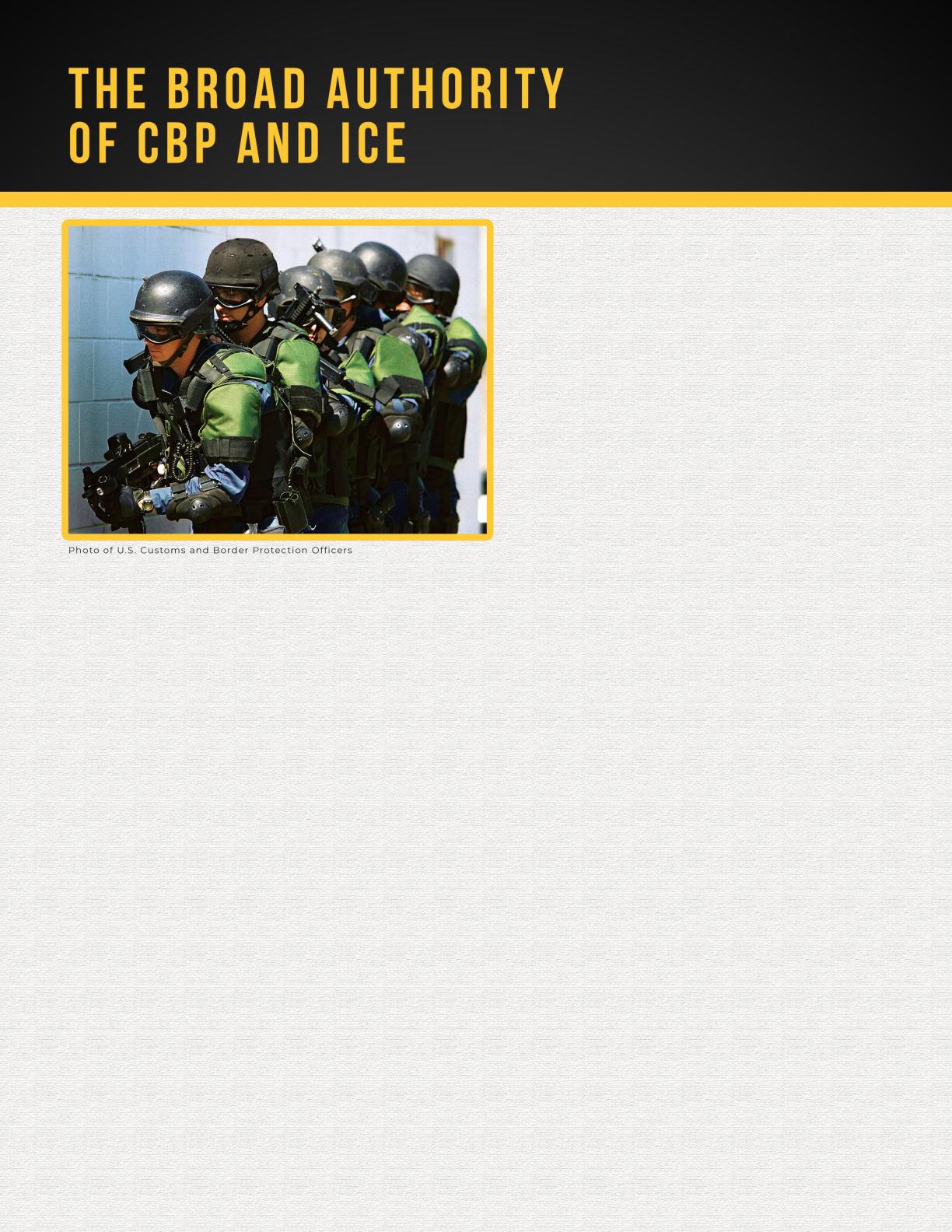
The creation of DHS accelerated the government’s operations along the U.S.Mexico border. CBP—now the largest law enforcement agency in the country manages border security operations and has grown in size and scope since its initial formation.
Congressional authority allows CBP to operate anywhere within “a reasonable distance from any external boundary of the United States.” The Justice Department has defined this “reasonable distance” as anywhere within a 100 air-mile radius of any U.S. border. Within this 100-mile zone, CBP has the authority to conduct warrantless searches on trains, buses, planes, cars, or any other form of transportation. Unfortunately, when deciding on this number, the Justice Department did not provide proper consideration and chose a number arbitrarily. As a result, nine of the ten largest U.S. cities fall within this boundary, and two-thirds of the U.S. population, about 200 million people, live within a jurisdiction where CBP can conduct unlawful searches and unconstitutional practices. A map of the border zone may be seen in Figure 3.
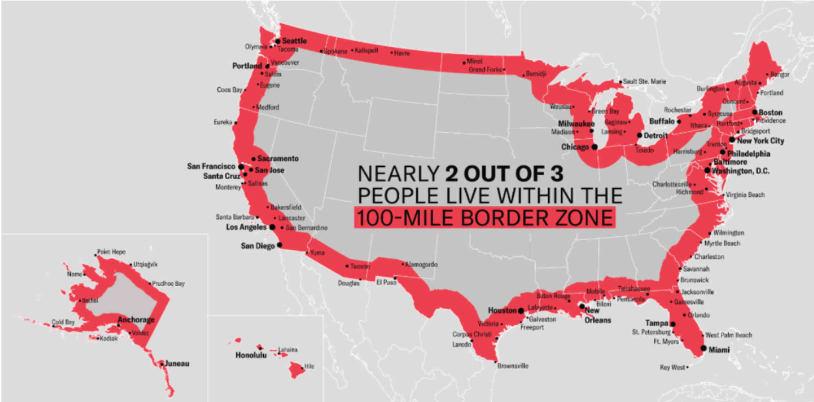
13
Figure 3. The 100-mile border zone. This map shows all the cities that fall within the 100mile zone that CBP is authorized to operate in and engage in practices that violate the Constitution. The residents in these areas are subject to CBP’s unconstitutional searches and seizures at any time. Source: The ACLU - The Constitution in the 100-Mile Border Zone.
In the “border zone,” agents can set up checkpoints to stop, question, and detain individuals they suspect to have committed immigration violations. Often these practices are motivated by racial factors. For example, a 2019 study by the ACLU of Michigan found routine racial profiling within the border zone. Agents recorded that 96% of people they stopped were non-white, according to the agency’s racialized “complexion codes.” Ultimately, Border Patrol practices create a de facto “Constitution-free” zone, where individuals in these areas, or those who simply encounter a Border Patrol agent, may have their constitutional rights violated.

Additionally, within 25 miles of the border, CBP maintains that it can enter private lands without a warrant, which clearly violates the Constitution’s fourth amendment. While the Justice Department maintains that CBP has the authority to operate within this 100 airmile border zone, ICE has jurisdiction to operate anywhere within the U.S. This increases the risk that the safety and livelihoods of Black and brown communities will be violated.
Federal courts have often ruled that border agent operations were unconstitutional. But due to inconsistent rulings and lack of oversight, many U.S. residents of all backgrounds and legal statuses may encounter CBP daily. Between 2006 and 2010, Border Patrol arrested and later released about 300 immigrants with legal status. OneAmerica documented a pattern of profiling and abuse on the Northern Border, including sending Border Patrol agents to the homes of Spanish-speaking 911-callers. In addition, people living in communities across the U.S.—within and outside the 100-mile border zone—are stopped and questioned by border agents while doing everyday things, such as going to the doctor or buying groceries and gas. These broad powers leave communities of color and immigrant communities subject to racial profiling, harassment, and arrest.
Efforts to “harden” the border have also included the installation of surveillance, including drones, ground monitoring, and electronic surveillance, dramatically increasing Border Patrol personnel, and erecting thousands of miles of border fencing. According to Pedro Rios, director of the U.S.-Mexico border program at the American Friends Services Committee, CBP uses “military-style enforcement tactics, equipment, and strategies to ‘control’ the border, including drone planes, military helicopters, and the coordination of local law enforcement and federal forces.”
In addition to CBP’s surveillance tactics in border communities, ICE detention and removal tactics also strip migrants of their basic human rights. As the primary federal agency enforcing immigration laws in interior communities, ICE has been scrutinized for its policies and tactics. These include such abuses as family separation, horrific detention conditions, private contracts with local jails and prisons, and denial of basic human rights for migrants—ranging from denial of medical care and fair hearings in court to excessive use of force to a documented pattern of discrimination against Black migrants. When formal complaints are filed against an agent, 95.9% result in “no action” against the accused official. In one study by the Southern Border Communities Coalition, more than half of migrants who encounter CBP reported being denied medical care, and one in ten reported being left without food and water.
14
Moreover, ICE needlessly entangles local law enforcement agencies (LEAs) in carrying out federal immigration responsibilities. The Section 287(g) program authorizes county, state, and LEAs to enter into cooperative agreements with ICE to perform federal immigration enforcement functions.
Funding for this program is charted in Figure 4. The involvement of LEAs in federal immigration enforcement and the broad discretion given by Congress to perform these duties has led to rampant racial profiling and abuse complaints. A recent ACLU report found that most local partners under the 287(g) program had a documented history of civil rights complaints or other abuses. Under these cooperative agreements, deputized LEAs with four-week training are authorized to perform immigration enforcement functions in their communities. Deputized officers’ tactics can include, but are not limited to, questioning individuals about their immigration status, checking and entering data on DHS databases, making recommendations for detention and immigration bonds, and issuing Notice to Appear (NTA) filings that initiate the removal process.
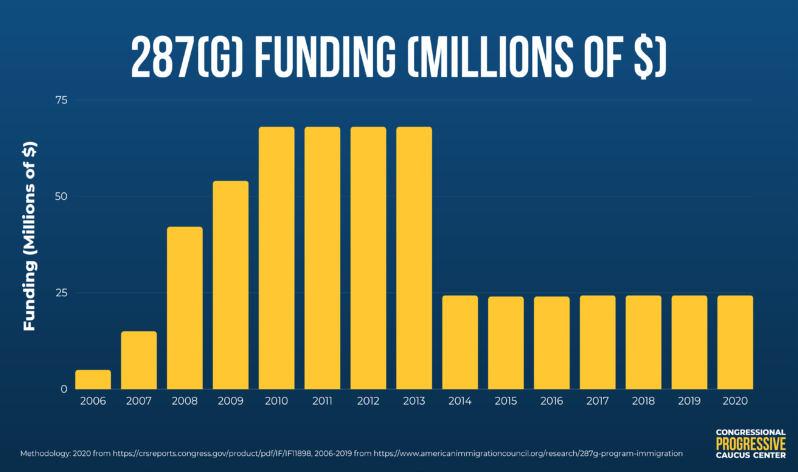
Correspondingly, many jurisdictions share information between local and state law enforcement agencies and ICE via memoranda of agreements. ICE’s detention and deportation infrastructure rely heavily on detainers, or immigration holds, to involve LEAs in the federal deportation system. The Secure Communities program (S-Comm), reinstated during the Trump Administration, requires fingerprint data from anyone arrested and booked into a local jail to be shared with ICE’s immigration database. This practice encourages racial profiling by local law enforcement, resulting in countless cases of unlawful detention of lawfully present immigrants, permanent residents, and U.S. citizens.

15
Figure 4. Section 287(g) program funding over time, 2006-2020.
Additionally, under the S-Comm program, ICE detention includes individuals not charged with a crime or wrongly arrested. These detentions have an immensely harmful effect on civil liberties without substantially benefiting national security. For example, the Cato Institute highlights research demonstrating that the S-Comm program does not secure communities more from crime and that it does not affect local crime rates The report debunks rhetoric that suggests undocumented immigrants are more prone to criminality than those native to the U.S.

Cooperation between local police and federal immigration enforcement can make immigrant communities reluctant to report crimes, leaving them vulnerable to criminal exploitation and making all our communities less safe. For example, one study found that immigrants were 61% less likely to report a crime they witnessed and 43% less likely to report being the victim of a crime if they knew that local law enforcement worked with ICE. The damage done to local trust has not gone unnoticed by law enforcement. The International Association of Chiefs of Police criticized the program in 2005, stating, “Local police agencies depend on the cooperation of immigrants, legal and [otherwise], in solving all sorts of crimes and maintaining public order. Without assurances that they will not be subject to an immigration investigation and possible deportation, many immigrants with critical information would not come forward, even when heinous crimes are committed against them or their families.”
Continual reliance on LEAs to interpret and make decisions on immigration detainers poses legal liabilities for localities; courts have found that detainers’ current administration and enforcement violate both Constitutional and statutory law. Specifically, rulings have declared that both ICE and LEAs violate the Fourth Amendment when they process detainers due to a lack of adequate probable cause. Moreover, LEAs do not have federal or state authority to make civil immigration arrests or detain individuals under the presumption of a civil immigration violation.

16
ICE Homeland Security Intelligence members training using armored vehicle at Fort Benning in Georgia.
Deaths at the Border

Since 1998, more than 9,515 people have died along the U.S.-Mexico border, according to the Washington Office on Latin America, a U.S.-based non-profit research and advocacy organization. Yet, despite those numbers, CBP has routinely failed to track deaths, regularly sabotaged life-saving efforts like water stations in the desert, and frequently engaged in practices that contribute to needless violence and deaths.
Border deaths have fluctuated but have remained persistently high since 1994 when the failed “prevention through deterrence” strategies deliberately made the border crossing more difficult and deadly by pushing people into more rural and isolated areas. As increased surveillance and border walls force people into more remote areas to cross, people face longer walks in deadly heat, a higher risk of drowning, and less access to lifesaving services or forensic investigators who can identify remains. In addition, due to the rural terrain and the scant local resources, many people who perish in the desert are not found. More than 2,000 people remain unidentified, according to a 2019 analysis, leaving thousands of families without answers as they search for their loved ones.
Deaths on the U.S.-Mexico Border have spiked alarmingly in recent years, as seen in Figure 5 above. In 2022, more than 800 people died while crossing the border, according to internal CBP figures, including the 53 people who died after being abandoned in a sealed semi-truck in San Antonio, Texas. The United Nations International Organization for Migration labeled the U.S. Southern Border the most deadly land crossing in the world.
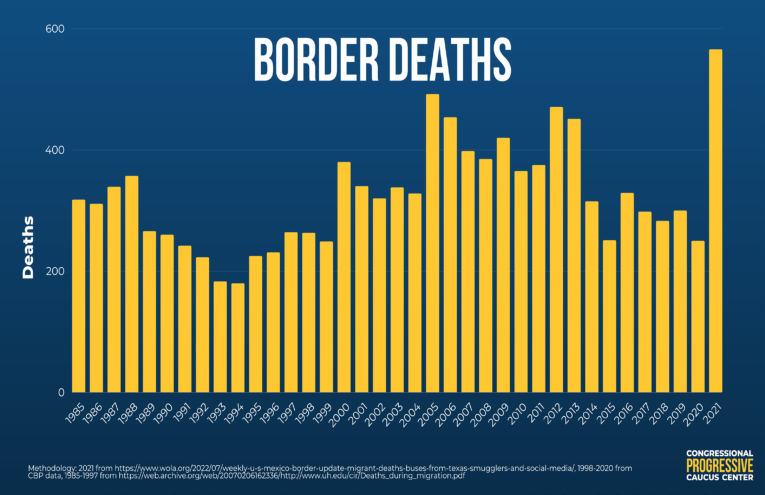 Figure 5. Deaths at the border, 1985-2021.
Figure 5. Deaths at the border, 1985-2021.
17
Several recent policies have undermined the ability of people fleeing for their lives to exercise the right to asylum. The Trump Administration’s so-called “remain in Mexico” or MPP policy stranded tens of thousands of people seeking safety to endure dangerous conditions in makeshift camps in Mexico. Human Rights First documented over 1,500 murders, rapes, kidnappings, and assaults against asylum seekers returned to Mexico under “remain in Mexico” policy. The Biden Administration ended the “remain in Mexico” policy but has not fully restored the ability of asylum seekers to present themselves. The Title 42 policy used an obscure public health provision to keep people from pursuing their legal right to asylum. Title 42 is subject to several court challenges, but currently remains in effect and continues to undermine the rights of asylum seekers. Human rights advocates have urged the Biden Administration to abandon punitive policies based on the failed deterrence-oriented approach, especially as the climate crisis causes heat waves and dangerous river conditions. Harsh border policies leave vulnerable people unable to exercise their right to apply for asylum and susceptible to violence.
ICE and Border Patrol Killings
CBP has killed at least 245 people since 2010, according to tracking by the Southern Border Communities Coalition, including 65 people killed by on-duty CBP agents, 89 people killed by CBP vehicles, and 48 people killed by the failure to provide medical attention, such as 7-year old Jakelin Caal Maquin who died of sepsis while in CBP custody. Additionally, more than 40 people died in ICE custody between 2017 and 2020, including people who were denied medical attention in detention, such as Roxsana Hernandez, a transgender woman seeking asylum in the U.S. who died in ICE custody after losing 40 pounds, exhibiting signs of starvation, dehydration, and pneumonia and being denied access to antiretroviral medication. Between 2010 and 2015, advocates examined another 74 deaths in ICE custody and found a stunning pattern of medical neglect and outright abuse.
Abuse and Neglect
In addition to the people killed along the border, CBP and ICE have a documented history of abuse targeting immigrants and communities of color. In 2021 alone, Human Rights Watch documented over 160 incidents of physical, sexual, and verbal abuse, denial of rights, and denial of medical care for asylum seekers. Several studies have found that this type of abuse is not isolated. Instead, it is a widespread systemic problem throughout CBP and ICE. In one 2013 study, researchers found 11% of migrants reported experiencing physical abuse, and 23% reported verbal abuse or racist slurs. The same study found that CBP took and did not return at least one belonging from more than one-third of people who had been deported. Stealing people’s belongings during deportation can leave vulnerable people at real risk, as it strands them without money, phones, documentation, or even life-saving medications.

18
Additionally, Black migrants face disproportionate rates of violence in detention—from physical abuse to higher bonds to higher rates of solitary confinement. For example, a 2022 study found that while Black migrants make up only 6 percent of people in ICE detention, 28% of the abuse-related reports to the Freedom for Immigrants hotline comes from Black migrants.
This pattern of racist abuse was evident in a secret Facebook group with more than 9,500 ICE and CBP members, including nearly half of all CBP agents. In this Facebook group, agents routinely posted racist and sexist content and joked about the deaths of migrants. Unfortunately, this behavior essentially goes unpunished (just two of the 60 agents charged with misconduct were fired).
Spotlight: Personal Story on the Treatment of Migrants
Alberto (name changed to protect his privacy) says U.S. militarism has shaped his whole life. Alberto, a 64 year old immigrant from El Salvador, fled to the U.S. in 1984 after being imprisoned and tortured by the U.S.-backed El Salvadoran military because of his work organizing workers during El Salvador’s Civil War. “I had to flee my country because of the torturers who were trained and funded by the U.S. The U.S. meddled in El Salvador and caused so much pain and so much suffering. I was lucky, I had friends in the U.S. who helped get me out, so I made it. But so many others didn’t.” But Alberto’s path to the U.S. was anything but smooth.
Alberto paid smugglers to get across the U.S. border and narrowly escaped deportation at a Border Patrol checkpoint. Although Alberto should have qualified for asylum as a political refugee, Alberto was one of the hundreds of thousands of refugees from Latin America denied safety in the U.S. in the 1980s. Reluctant to admit the horrific consequences of U.S. military intervention in Latin America, the U.S. routinely denied applications for asylum from people fleeing violence from the U.S.-backed regimes in El Salvador and Guatemala. It took a class action lawsuit, American Baptist Churches v. Thornburgh, to force the U.S. government to follow its own asylum laws and grant sanctuary to Guatemalan, El Salvadoran and other Central American refugees like Alberto.
Today, Alberto volunteers with local immigrant rights groups in his home of Vancouver, Washington. He says he sees many young undocumented immigrants facing many of the same struggles he faced. “These kids have no options. They are running from gang violence but then they get hurt or locked up on the border or they get stopped by police for nothing and then they are back in detention again. They are carrying pain from their homes and then the pain of finding your place in a strange country and then they get locked up in these horrible detention centers. If they are sent home, they risk losing their lives, but if they stay here it means living their lives in the shadows and in constant fear. How is this life? How can anyone recover?” Alberto says that life has gotten much harder since 2016. “Around here, it’s pretty rural. You’d always have some people who didn’t like you. But now, after Trump, people are proud to hate you. They are proud to tell you to go home. But we can’t go home. There’s too much violence. And we can’t seem to just live in peace here either. We have to fight to escape and then we have to fight to stay and then we have to fight to just live in peace.”
*Note: Alberto’s words were translated from Spanish.

19
Moreover, immigrants, refugees, and asylum seekers, including unaccompanied minors, face horrifying conditions, medical neglect, trauma, and abuse in ICE detention facilities. In 2018, an ICE whistleblower documented routine medical negligence and falsifying jail records after deaths and permanent injuries in ICE detention. The Intercept uncovered 1,224 allegations of sexual abuse or rape in detention between 2010 and 2017. The ACLU and MALDEF documented hundreds of cases of sexual abuse in detention centers in Texas, adding to the widespread evidence of systemic sexual assault in immigration detention.


In 2020, a whistleblower exposed a pattern of forced and coerced sterilizations of women in the Irwin Detention Center in Georgia and dangerous COVID-19 conditions. This horrifying abuse builds on a long practice of state-sponsored forced sterilizations targeting women of color in the United States.

20
Ursula migrant detention center in McAllen, Texas, July 2019
DHS, and ICE and CBP in particular, lack sufficient oversight and accountability measures, enabling the abuse and neglect outlined above and widespread corruption. A groundbreaking government-commissioned report in 2015 found that arrests for corruption of CBP personnel “far exceed, on a per capita basis, such arrests at other federal law enforcement agencies.” Despite the commission’s findings, few reforms or additional oversight measures were adopted.

An additional whistleblower report revealed that DHS officials politicized U.S. intelligence information during the Trump Administration. Trump officials provided false testimony before Congress and urged the alteration of reports contradicting their rationale for using more hard-line immigration policies on the Mexico-U.S. border. For example, evidence showing migrants fleeing “corruption, violence, and poor economic conditions” were altered to fit the White House’s narrative of terrorists crossing the border. Despite a change in Administration, false reports regarding border security have had a lasting societal impact. An NPR/Ipsos July 2022 poll shows that more than half of Americans believe there’s an “invasion” at the Southern Border.
These concerns point to DHS’ systemic issues of disregard for the rule of law and unethical actions, which counter the agency’s mission to secure U.S. borders and keep Americans safe. Moreover, as DHS continues to increase in size and scale, oversight and accountability mechanisms have struggled to keep pace. DHS is the third-largest federal department and, in FY22, had $185.74 billion distributed among its 17 sub-agencies. Despite its size, however, Congressional oversight of the department remains fractured.
DHS is a large department with an overwhelming amount of “overseers,” unlike other departments. Most major Cabinet departments have one or two substantive Congressional committees in each chamber bearing the main responsibility for oversight. For example, the largest government agency, the Department of Defense, is primarily overseen by the House and Senate Armed Services Committees. A few subcommittees and Intelligence committees play a secondary role in oversight. For the Department of Veterans Affairs, the second largest government agency, primary jurisdiction is held within the House and Senate Veterans Affairs Committees. By comparison, more than 90 Congressional committees and subcommittees claim jurisdiction over some part of DHS. In other words, the consolidation of executive branch agencies that led to the department’s formation is not mirrored by the legislative branch. This disorganized and fragmented structure causes delays in resources and confusion, making actual Congressional oversight of DHS more difficult.
21
Moreover, internal channels to prevent and halt misconduct—program audits, whistleblowers, and the Inspector General’s Office—are deeply flawed. A 2021 GAO report revealed “long-standing management and operational weaknesses” within DHS’ Office of Inspector General (OIG). It determined that the department had “no overarching internal quality assurance system for audit, inspection, evaluation, and other work… DHS OIG cannot know if its internal processes ensure that its work (1) adheres to its policies and (2) meets established standards of performance.”

The lack of oversight for ongoing misconduct also shows up with CBP officers, as most instances of abuse occur with impunity. For example, more than 95% of internal investigations of abuse at CBP ended with the agency taking “no action” against an officer. This abuse was facilitated by Critical Incident Teams, which withheld, destroyed, and corrupted evidence that could have led to agency accountability. The Teams were finally eliminated in May 2022.
CBP has also failed to accurately collect, report, and evaluate data. The agency has repeatedly been found to systemically undercount deaths of migrants at the border. Two 2022 GAO reports observed that CBP failed to provide data to the Missing Migrants Program, which the agency set up to reduce deaths along the southwest border. CBP also failed in its legal responsibility to report this data to Congress and to disclose data limitations.
Because DHS continues to receive more weapons, funding, and resources from the federal budget, more oversight of its practices and operations—which includes those of CBP and ICE—is necessary. These departments receive weapons of war, which are used against migrants and communities along the border. In addition, the “beefing up” of DHS and border security has contributed to the widespread overreach of authority and racist and abusive tactics.
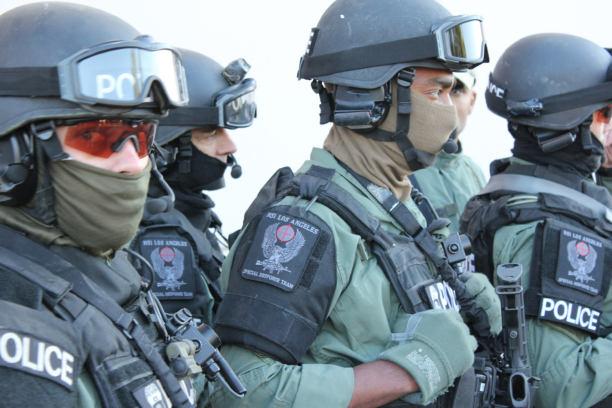
22
Los Angeles Special Response Team (SRT) within Homeland Security Investigations (HSI) of the U.S. Immigration and Customs Enforcement
What Congress and the Administration Could Do

The Biden Administration and Congress could ensure more accountability and oversight of DHS operations, increase accountability at the border, and reduce military spending that leads to a militarized border. Below, we list recommendations by CPC Center partners and others that could help demilitarize our border communities:
• Cut the Department of Defense budget and end weapons transfers to DHS. Military spending has reached historically high levels. For FY2023, the total defense budget was $858 billion. A share of the budget also benefits DHS, which receives weapons from the Pentagon through various transfer programs, such as the 1033 program.1 The NDAA also authorizes funding and sets policies for various defense-related operations at DHS.
• End US-financed wars and weapons support abroad that contribute to global destabilization. U.S. interventionism, sanctions, and international arms sales make the U.S. government complicit in human rights abuses and war crimes around the world. Enabling war abroad leads to the destabilization of countries and their institutions, which is one factor that leads migrants to leave their country, potentially seeking refuge or asylum in the U.S. Additionally, the U.S. must end weapons sales, logistical, spare part, and intelligence support to countries that commit human rights abuses with this support and wage war.
• Build a fair immigration system with a pathway to citizenship. Our immigration system requires a complete reimagining that allows our communities and economy to continue to benefit from the talents of new Americans, keeps families together, integrates newcomers into the fabric of our society, treats each person with dignity, and reflects our deepest values.
• End 287(g) and other programs that enable direct enforcement of immigration laws by LEAs and information sharing to ICE. Despite rulings clarifying that LEAs are not authorized to carry out immigration enforcement, programs like 287(g) continue to exist. ICE could also eliminate other programs that rely on cooperation and participation from local and state law enforcement, such as the S-Comm program.
• Cut funding for harmful ICE and CBP programs and redirect funding towards community-based alternatives to detention and services for border communities. Our government could use proven community-based alternatives to detention to assist immigrants on the border and redirect harmful funding to programs that help communities thrive, like employment, housing assistance, and healthcare.
1 The CPCC will publish further reports analyzing the data from these weapons transfers. 23
Restructure the Department of Homeland Security. DHS could be restructured into a smaller-scaled and more manageable agency focused on counterterrorism, cybercrimes, and counterespionage. The remaining departments could be placed into smaller departments that allow for more oversight.
• Overhaul Department of Homeland Security use of force policies. DHS could develop standards for its agencies on what information must be reported for the use of force incidents and establish oversight mechanisms to ensure the consistency and completeness of reporting that aligns with international standards. In addition, DHS could follow a May 2022 executive order overhauling use-of-force policies that directs the heads of Federal LEAs to implement policies that “reflect principles of valuing and preserving human life” and report misconduct to the newly-created National Law Enforcement Accountability database.
• Protect the rights of asylum seekers and end punitive border-crossing policies that endanger lives and separate families. Protect the rights of asylum seekers and end punitive border-crossing policies that endanger lives and separate families. The right to flee danger and seek asylum is protected under both international and U.S. law. The Biden Administration could end policies undermining the rights of refugees and asylum seekers, including Title 42, expedited removal, and other bans on asylum seekers. In addition, the administration could admit more refugees, especially refugees fleeing the devastation of the U.S. war in Afghanistan.
Congressional lawmakers have introduced several bills that could make significant changes to our immigration and asylum systems, such as:
• The New Way Forward Act introduced by Representatives Chuy García (DIL-04), Ayanna Pressley (D-MA-07), and Pramila Jayapal (D-WA-07) would rebuild our immigration system and restore due process.
• The Dignity for Detained Immigrants Act, introduced by Representatives Pramila Jayapal, Adam Smith (D-WA-09), and Senator Cory Booker (D-NJ), would end inhumane conditions in detention centers and implement other measures to protect the civil and human rights of immigrants.
• The U.S. Citizenship Act, introduced by Senator Bob Menendez (D-NJ) and Congresswoman Linda Sanchez (D-CA-38), would rebuild our asylum and refugee resettlement system by ending the onerous one-year filing deadline, increasing funding for refugee and asylum officers to reduce the backlog, and establishing designated centers to resettle refugees.

•
24
Border communities, advocates, researchers, and immigrant rights organizers are doing critical work to monitor and document militarization and abuses on the U.S. border. We encourage you to follow the work of experts on the ground including the following resources:
Community-Led Recommendations for Reform
New Border Vision - Southern Border Communities Coalition
The Firm and Firm Action Vision - The Fair Immigration Reform Movement (FIRM) and FIRM Action
Beyond the Enforcement Paradigm: A Vision for a Transformative Budget for U.S. ImmigrationDefund Hate Coalition
Solutions for a Humane Border Policy - National Immigrant Justice Center
Oversight, Accountability, and Civil Rights
Know Your Rights: The 100 Mile Border Zone - ACLU
The Green Monster: How the Border Patrol became America’s most out-of-control law enforcement agency - Southern Border Communities Coalition
Crossing the Line: Corruption at the Border - Southern Border Communities Coalition
Four Ways to Increase Protections for Children Arriving at Our Borders - Young Center for Immigrant Children’s Rights
Deaths and Abuses on the Border
Restoring the Legal Right to Seek Asylum: The Case for Ending Title 42 - Progressive Caucus Action Fund
Death, Damage, and Failure: Past, Present, and Future Impacts of Walls on the U.S.-Mexico
Border - ACLU Border Rights Center, Equal Voice, Southern Border Communities Coalition, Southwest Environmental Center, Sierra Club, and the Center for Biological Diversity
On the Borderline: Abuses at the US Mexico Border - American Friends Service Committee
Tracking Deaths on the Border - Southern Border Communities Coalition
Abuse of Power and Its Consequences - Southern Border Communities Coalition
They Treat You Like You Are Worthless’: Internal DHS Reports of Abuses by US Border OfficialsHuman Rights Watch
Caught in the Web: The Role of Transnational Data Sharing in the U.S. Immigration System - National Immigrant Justice Center
Deaths and Abuses in Detention
Prejudicial and Unreliable: The Role of Police Reports in U.S. Immigration Detention & Deportation Decisions - National Immigrant Justice Center
Uncovering the Truth: Violence and Abuse Against Black Migrants in Immigration Detention - Black Alliance for Just Immigration, Black LGBTQIA and Migrant Project, UndocuBlack Network, Freedom for Immigrants
Punishing Trauma: Incident Reporting and Immigrant Children in Government Custody - National Immigrant Justice Center Detention 101 - Detention Watch Network
Beyond the Bridge: Documented Human Rights Abuses and Civil Rights Violations Against Haitian Migrants in Del Rio, Texas Encampment - Haitian Bridge Alliance
Cruelty and Corruption: Contracting to Lock Up Immigrant Women for Profit at the Hutto Detention Center - Texas Law Immigration Clinic and Grassroots Leadership
COVID-19 Negligence, Sexual Assault, Retaliation, Verbal Abuse, Religious Discrimination, AntiBlackness, and Deplorable Conditions at Krome North Services Processing Center in Miami, Florida
- Haitian Bridge Alliance 25





 President George W. Bush signs the Homeland Security Appropriations Act of 2004 on October 1, 2003.
President George W. Bush signs the Homeland Security Appropriations Act of 2004 on October 1, 2003.












 Former President of Honduras Juan Orlando Hernández
Former President of Honduras Juan Orlando Hernández






 Figure 5. Deaths at the border, 1985-2021.
Figure 5. Deaths at the border, 1985-2021.






